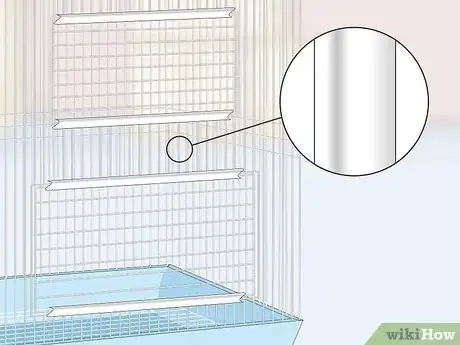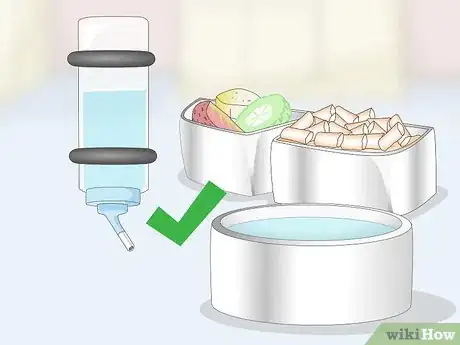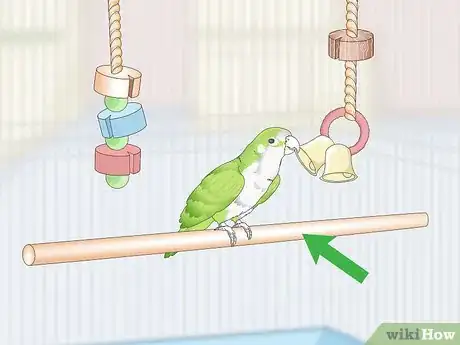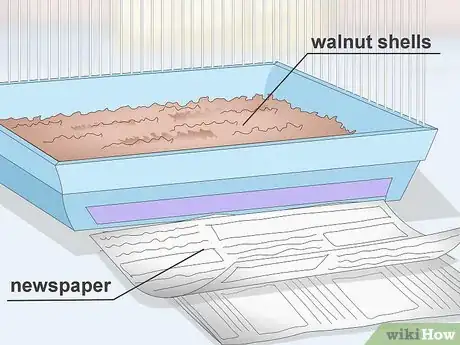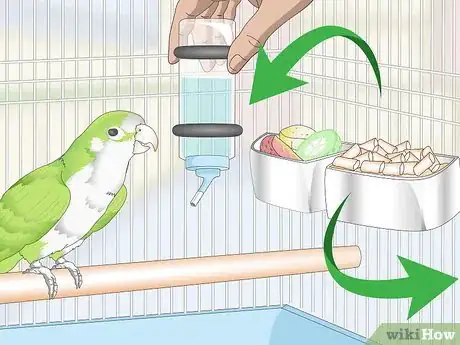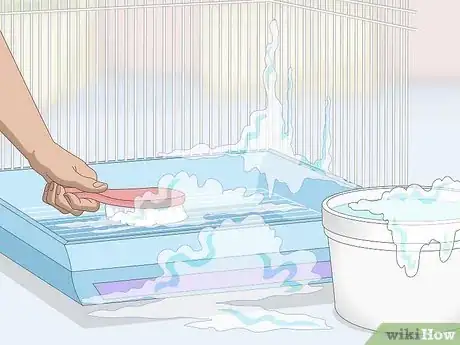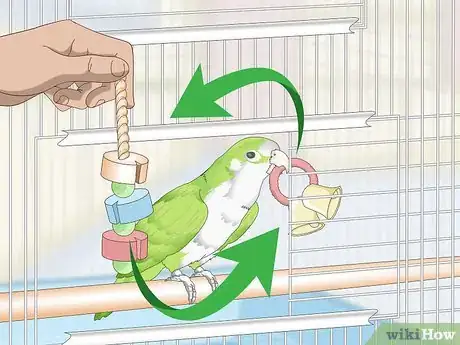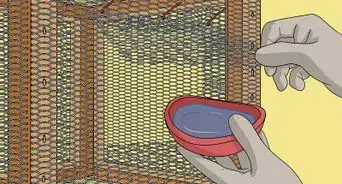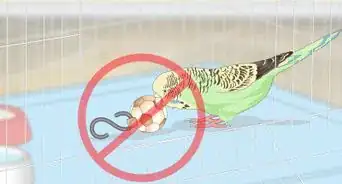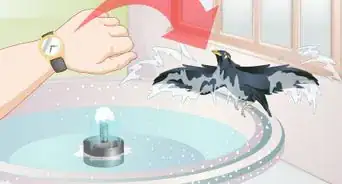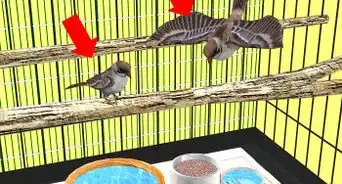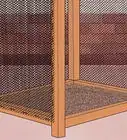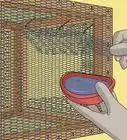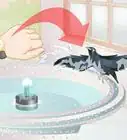This article was co-authored by Pippa Elliott, MRCVS. Dr. Elliott, BVMS, MRCVS is a veterinarian with over 30 years of experience in veterinary surgery and companion animal practice. She graduated from the University of Glasgow in 1987 with a degree in veterinary medicine and surgery. She has worked at the same animal clinic in her hometown for over 20 years.
This article has been viewed 15,068 times.
When you have a Quaker parrot you should make sure that it is housed properly. Since your bird will spend most of its home in its cage, the cage should fulfill all of its needs. Getting the right supplies, assembling the cage in the correct way, and maintaining the cage properly will help assure that your bird thrives in its home.
Steps
Getting the Right Cage
-
1Buy a correctly-sized cage. Your Quaker parrot deserves to have enough space to live in happily. It will need enough space to spread its wings and to have separate spaces to nest, eat, and play. However, Quaker parrots are relatively small birds, so one bird typically needs a cage that is at least 18 inches (45.7 cm) tall, 18 inches wide, and 18 inches (45.7 cm) deep.
- If you can afford to buy your bird a bigger cage, then you should do that. It is better to have a bigger cage but not totally necessary.
- Avoid getting a cage that is tall and narrow, as this may not provide enough space for your parrot.
-
2Pick a cage that is safe for your parrot. In order to keep your Quaker safe in its home, you need to buy a cage that provides as few hazards as possible. With this in mind, get a cage that has doors that open sideways or down, instead of snapping shut. These can injure your bird.
- Also, make sure that the cage bars are close enough together so that your bird cannot get its head stuck in between them.
Advertisement -
3Buy a cage made of non-toxic materials. You should make sure to get a cage that is made of materials that will not be toxic to the bird if it chews on the bars. Your bird will likely nibble on its cage and you don't want it swallowing paint and rust while it nibbles.
- The best cages for Quaker parrots are made of stainless steel or powder-coated steel. However, these are also typically the most expensive.
- Above all, you want to avoid cages that are coated in lead paint or cheap materials that the bird will easily chip off and then ingest. Talk to your local store associate to figure out the right product for you.
Gathering Supplies for the Cage
-
1Purchase food and water dishes. Your Quaker parrot will need several food dishes and one designated water dish. There are a wide variety of dishes available for bird cages, so just make sure that the ones you choose are sturdy. The dishes should not be made of a material that your Quaker could easily break off, such as thin plastic.
- You have several options when it comes to water dishes. You could buy a typical dish, which the bird could also use for bathing but which will get dirty quickly. You could also get a water bottle for the bird's cage, which will keep the water clean for longer but cannot be used for bathing like the dish can.
-
2Buy cage accessories. In addition to a cage, your Quaker will need some accessories in its cage, specifically a variety of perches and toys. Buy an assortment of perches, some can even be natural branches, ladders, or swings. You should also buy a variety of toys, including ropes, bells, and mirrors.[1]
- Focus on giving your Quaker a variety of textures, sounds, and colors when picking out toys.
- If you get your bird a water bottle for its cage, you will also need to get it a small dish for the bottom of its cage where it can bathe.
-
3Consider buying cage lining material. There are a wide variety of cage lining materials that can be put at the bottom of your Quaker's cage. You can use cob, walnut shells, or newspaper on the bottom of your bird's cage. If you want to use cob or walnut shells, you will need to purchase them. If you want to use newspaper, you can likely get your hands on some for free. As such, many Quaker owners choose to use newspaper.
- Cob or walnut shells for the bottom of your bird's cage can typically be found at most pet stores but you may need to order them from an online retailer if none is available at your local shop.
Maintaining Your Quaker Parrot's Home
-
1Replace food and water daily. In order to keep your Quaker healthy and happy, you should provide it with fresh drinking water and food every day. This will help ensure that your bird gets all the nutrition it needs and that bacteria in spoiled food or dirty water does not make your bird sick.
- When switching your bird's food and water you should also clean the food and water containers. Scrub them out with soap and hot water daily so that they don't harbor bacteria and disease.[2]
-
2Clean the cage regularly. In addition to cleaning out your bird's food and water dishes, you should clean the bottom of your bird's cage daily and the whole cage weekly. Pull out soiled cage lining every day, clean the lining pan with soap and water, and put new lining material at the bottom of the cage. Scrubbing the entire cage clean weekly will eliminate any bacteria and disease that may be developing, and will help keep your bird healthy.[3]
- When cleaning your bird's cage, use a mixture of soap and hot water. Make sure that the cage is completely dry before replacing items back into the cage.
- Remove your bird from its cage before doing a thorough cleaning. Place it in a temporary cage while you are cleaning its permanent cage.
-
3Make sure the cage is securing locked at all times. Quaker parrots are known to be intelligent birds that can figure out how to get out of cages that are not well secured. In order to avoid this, make sure that your bird's cage is well secured every time you close it.
- While figuring out how to open its cage probably stimulate its mind, a Quaker that gets out of its cage can get injured during the escape or by a hazard in your home, such as another pet.
-
4Switch out toys regularly. In order to keep your parrot stimulated and happy, you should switch out its toys on a regular basis. Giving your bird new puzzles and toys will help the bird avoid boredom, which can cause a bird to get depressed and unhealthy. Make sure that there are several toys in your bird's cage at all times, so your bird can choose which one it wants to play with.
- Quaker parrots are very smart birds, so it's a good idea to give them puzzle toys that they can work on figuring out.
- Consider getting toys that are advertised as suitable for cockatiels, conures, or parrots.
Warnings
- Keep male and female Quaker parrots separated, unless you want breeding to occur.⧼thumbs_response⧽
- Don't put Quaker parrots in a cage with other types of birds.[4]⧼thumbs_response⧽
References
About This Article
To house a Quaker parrot, start by choosing a stainless steel or powder-coated steel cage that's at least 18 inches tall, 18 inches wide, and 18 inches deep. Make sure the cage bars are close enough together so the bird can't get its head stuck in between them. Next, line the bottom of the cage with walnut shells or newspaper and add multiple food and water dishes. Then, install several perches and place a variety of toys, like ropes, bells, and mirrors, inside the cage. Finally, replace the soiled lining daily and scrub the entire cage every week with warm water and soap. For tips on different kinds of perches that your parrot might like, read on!


